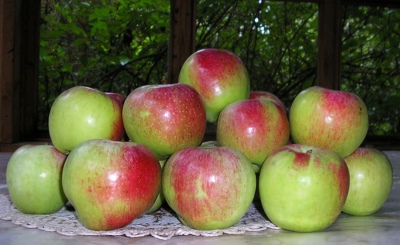
- Authors: Moscow State University M. V. Lomonosova, S. I. Isaev
- Taste: sweet and sour with light spice
- Scent: light
- Fruit size: large
- The beginning of fruiting varieties: for 6-7 years
- Ripening terms: winter
- Removable maturity: end of September - beginning of October
- Keeping quality: until April
- Appointment: universal
- Appeared when crossing: Welsey x Antonovka ordinary
Apple-tree Moscow Winter is one of the most attractive fruit plants. The variety is not too new (it has been cultivated for almost 60 years), but it is well studied in all details. For novice summer residents and gardeners, it will be very useful to get acquainted with this culture.
Breeding history of the variety
Moscow Winter was brought out by breeders of Moscow State University. To obtain a hybrid, Antonovka ordinary and Welsey were crossed. The authorship of the selection belongs to S.I. Isaev. We developed the plant in 1963. Official grade trials were carried out in 1977.
Description of the variety
The crop is optimized for growing in fairly harsh weather conditions. The apple tree is suitable for use in private and industrial gardening. The tree is very tall, and therefore not all gardeners will be able to cope with it. If you do not control growth, Moscow Winter can rise up to 8-10 m. But all these problems are compensated by high consumer characteristics.
Features, pros and cons
The growth is fast. Over the course of a year, the tree will add 15 cm each. The crown of young apple trees resembles a wide pyramid. Mature trees have a crown in the form of a wide oval. The number of leaves is moderately large; they are large and are held on branches by fleecy cuttings.
To cope with such a disadvantage as too active development, stopping the growth point helps. Yield adjustment is impossible if the apple tree was allowed to grow up to 5-6 m. Susceptibility to fungal infections is at an average level. However, all of these problems overlap impressively:
attractive qualities of the crop;
the plant's ability to withstand harsh weather conditions;
a decent level of adaptation in different areas.
Ripening and fruiting
Moscow Winter - predictably apple tree with winter maturation. The fruits will ripen by the end of September - early October. The first harvest is possible for 6-7 years. The active period lasts up to 50 years. With proper adjustment of the number of flowers and ovaries, annual fruiting can be achieved.
Yield
One tree of this culture is capable of producing 150 kg of fruit per season. The spread is sometimes from 140 to 170 kg. If you grow Moscow Winter on an industrial scale, you can get up to 100 centners (centners) per hectare. But positive results are achieved only with scrupulous adherence to agricultural standards. You will have to water and feed the apple tree very carefully.
Fruits and their taste
There are light green and greenish yellow apples. The dark red coat is well expressed on the entire surface of the fruit. The smooth rind has a good waxy coating. And also worth noting:
pleasant light aroma;
light green very juicy pulp;
the entry of sugars from 8.3 to 12.4%;
sweet and sour, slightly spicy taste;
significant keeping quality (it can last until April).

Growing features
Moskovskoe Zimnee is a variety that requires a sunny place. Growing in the shade turns into crushing the fruit. The soil must be well aerated. Do not use areas where groundwater reaches closer than 3 m to the surface. The use of chernozem, sandy loam and loam is encouraged.



Top dressing
To feed the apple tree you need:
mineral complexes;
humus;
superphosphate;
compost.

Frost resistance
The apple tree's resistance to cold is quite high. Complicated techniques to protect it will not be required. Usually limited to wrapping with burlap or using grass, straw mats. Covering young trees is especially important. Adult specimens often cope with winter weather on their own.

Diseases and pests
Moskovskoe Zimnee moderately well tolerates scab. Powdery mildew resistance is also quite high. But preventive protection is imperative. Fire blight and cytosporosis pose a serious threat. It is worth noting that the apple of this variety is threatened by rodents in the first place; there are no specific insect pests that would attack only Moscow Winter.

The apple tree is a popular fruit crop among gardeners. It can be found in many summer cottages. But at the same time, such trees are often affected by various diseases. It is very important to recognize the disease in time and carry out the necessary procedures for a speedy recovery. Otherwise, the fruits will be spoiled, and the tree itself may die altogether.












































































